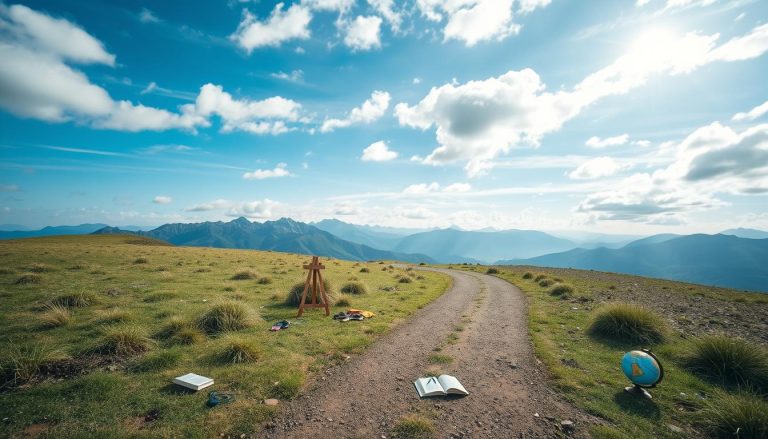Ancient aqueducts were complex systems that carried water from far-off places to cities. They were built with stone, brick, and concrete. The Roman aqueducts used gravity to move water, thanks to their smart design.
These systems had important parts like the water source, intake, channels, arches, and pipes. They brought clean water, helped health, boosted the economy, and showed off engineering skills.
Key Takeaways
- Ancient aqueducts were advanced hydraulic infrastructure projects that transported water over long distances to cities.
- Roman aqueducts relied on gravity and precise engineering to maintain a steady water flow.
- Aqueducts were vital for improving public health, enabling economic growth, and showcasing engineering accomplishments.
- The construction of aqueducts involved various key components, including the water source, intake structures, channels, arches, and distributing pipes.
- Aqueducts have left a lasting legacy as engineering marvels of the ancient world.
Understanding Ancient Aqueducts: The Foundation of Early Civilization
The history of hydraulic engineering starts in ancient times. Back then, people needed to manage water well. Aqueducts were key to early cities, laying the groundwork for historical infrastructure and classical architecture.
The Origins of Hydraulic Engineering
Early societies needed water and ways to move it. They built amazing systems like the Indus Valley’s toilets and Babylonia’s clay pipes. These show how smart our ancestors were in managing water.
Key Components and Basic Principles
- Water sources, such as rivers, lakes, and springs
- Carefully engineered channels and aqueducts to transport water
- Arches and support structures to maintain the flow and integrity of the system
- Intricate distribution networks to deliver water to communities
The secrets of these ancient hydraulic engineering wonders were simple. They used gravity to move water, making sure it flowed smoothly to its destination.
Role in Urban Development
Aqueducts were vital for ancient cities to grow. They brought water, helping cities get bigger, healthier, and more beautiful. The Romans, for example, built over 57 miles of aqueducts. They used lead pipes to bring water to their vast empire, changing cities forever.
“Plumbing has been a vital component of human settlements for thousands of years, emphasizing the importance of regular maintenance throughout history.”

Roman Engineering Excellence: Masters of Water Management and Ancient Aqueducts
Ancient Roman engineers were unmatched in water management. They built complex aqueduct systems that changed how cities got water. Famous names like Sextus Julius Frontinus and Marcus Vitruvius Pollio helped improve aqueduct design and building.
The Romans got water from springs, rivers, and lakes, often far from their cities. The Aqua Claudia, over 68 miles long, shows their skill, bringing water to ancient Rome. They also created advanced drainage systems, like the “cloacae,” to handle wastewater and storm runoff.
| Architectural Marvel | Span (meters) |
|---|---|
| Porta Marzia in Perugia | 6 |
| Pont du Gard aqueduct in France | 22 |
| Tagus River bridge at Alcántara in Spain | 30 |
| Dome of Nero’s Golden House in Rome | 15 |
| Pantheon in Rome | 43.2 |
| Baths of Diocletian in Rome | 26 |
| Basilica of Constantine in Rome | 26 |
| Basilica of Constantine at Trier | 23 |
| Hagia Sophia in Constantinople | 32.6 |
| Palace at Ctesiphon | 25 |
The table shows the impressive spans of roman engineering marvels. It highlights the historical hydraulic engineering skills of the Romans. These structures, like aqueducts, bridges, and domes, show the Romans’ skill in water management and architectural innovation.

“Roman concrete survived for almost 2,000 years with no maintenance, while modern concrete based on Portland cement produces 8 percent of carbon dioxide emissions worldwide.”
The Romans used innovative materials and techniques, like Roman concrete. This allowed them to build structures that lasted for centuries. It shows their engineering excellence in water management.
Materials and Construction Techniques in Aqueduct Building
The ancient Romans were experts in building aqueducts. They used new techniques and materials to create these wonders. At the core of their success was Roman concrete, known for its strength, durability, and ability to keep water out.
The Revolutionary Use of Roman Concrete
Roman concrete was a mix of volcanic ash, lime, and crushed stone. This mix changed how aqueducts were built. It made strong, water-resistant structures that lasted for centuries.
Many Roman aqueducts, like the Aqua Claudia, still amaze us today. It once carried over 6.5 million cubic feet of water to Rome daily.
Arch Design and Structural Innovation
The Romans were great at designing arches. These arches helped their aqueducts cross valleys and ravines. The Aqua Claudia aqueduct, for example, had a viaduct that reached 90 feet high.
The Romans also used stone, brick, and concrete to support the aqueducts. These materials helped keep the water flowing and the structure strong. This made the aqueducts true marvels of engineering.
Water-Proofing Methods
To keep their aqueducts from leaking, the Romans used special methods. They applied waterproof cement and planned the channel’s slope carefully. These steps helped the aqueducts last longer and work better.
The Romans’ skills in materials, design, and water-proofing changed aqueduct building forever. Their work is still admired today for its engineering excellence.
| Aqueduct | Construction Timeline | Key Features |
|---|---|---|
| Aqua Appia | 312 BC | First Roman aqueduct, built by Appius Claudius Caecus |
| Aqua Virgo | 19 BC | One of the remaining functioning aqueducts, still supplying the Trevi Fountain |
| Aqua Claudia | AD 38 – AD 52 | Delivered over 6.5 million cubic feet of water to Rome daily, used tuff and travertine stone in construction |

“Roman aqueducts are considered enduring monuments to the engineering genius, resourcefulness, and technical legacy of the Roman Empire.”
The Gravity-Powered Marvel: How Ancient Aqueducts Worked
The ancient aqueducts of the Roman Empire were true marvels. They used gravity to move water over long distances. This provided cities and towns with a steady supply of clean water.
The Roman aquarii, or engineers, placed water sources high up. This let water flow down, using gravity, without pumps. The aqueducts’ slope was carefully planned to control the flow and prevent damage.
The scale and engineering of these systems were amazing. For example, the Aqua Claudia aqueduct was 69 kilometers long. It took 14 years to build, showing the Romans’ skill in using gravity to bring water to cities.
“The construction of aqueducts showcased Roman engineering prowess and organizational skills, impressing citizens and rival nations.”
These aqueducts not only supplied water but also improved health. They brought clean water to baths, fountains, and homes. This helped reduce diseases and promote hygiene.
The legacy of these marvels is still seen today. Places like the Pont du Gard in France are standing tall. These ancient structures show the Romans’ ingenuity and problem-solving skills.

Notable Architectural Features and Design Elements in Ancient Aqueducts
The ancient Romans were true masters of engineering. Their aqueduct systems show off their amazing architectural skills. These structures didn’t just move water; they also solved big challenges in the landscape.
Aqueduct Bridges and Support Systems
The Romans built incredible aqueduct bridges, like the famous Pont du Gard in France. These bridges spanned valleys and rivers with arches and pillars. The Pont du Gard, over 150 feet tall, proves the Romans’ skill in aqueduct bridges and architectural wonders.
Water Distribution Networks
Under the bridges, the Romans built complex underground channels and networks. These systems brought water to homes, baths, and important places in cities. They used smaller pipes and channels to make sure everyone had access to water.
Maintenance Access Points
The Romans also built special maintenance access points in their aqueducts. For example, the spiral “ojos” in Peru’s Nasca aqueducts. These spots helped with upkeep, repairs, and even used wind power for water distribution. It shows their careful planning and attention to detail.

| Architectural Feature | Purpose | Notable Example |
|---|---|---|
| Aqueduct Bridges | Spanning valleys and rivers to support water channels | Pont du Gard, France |
| Underground Channels | Distributing water to homes, public baths, and other facilities | Aqueduct system of Ancient Rome |
| Maintenance Access Points | Facilitating inspections, repairs, and wind-powered pumps | Spiral-shaped “ojos” in Nasca aqueducts, Peru |
Famous Ancient Aqueducts Systems Around the World
Across the globe, ancient classical architectural wonders abound. Yet, the Roman Empire’s engineering stands out. Their eleven aqueducts delivered one million litres of water daily. This shows their advanced hydraulic skills.
The Aqua Appia, built in 312 BC, was the oldest Roman aqueduct. It could carry about 75,000 cubic meters of water daily. The Aqua Marcia, built in 144 BC, cost a huge 180,000,000 sestertii. The Aqua Alexandrina, from 226 AD, had 34 arches at Fosse di Torre Angela, 140 at Centocelle, and 52 at Torpignattara.
Outside Rome, the Pont du Gard in France and the Segovia Aqueduct in Spain are famous. The Nasca Aqueducts in Peru show pre-Inca hydraulic engineering. They have unique spiral-shaped ojos (eyes).
The Roman Aqueduct system stretched about 800 kilometers. Only 50 kilometers were above ground. It supplied water for daily life, fountains, and public baths. It also helped mines, mills, and agriculture.
“By the early fourth century AD, Rome was being supplied by more than twelve aqueducts, which together could bring more than a million cubic meters of fresh water to the city daily.”
Ancient Aqueducts: Ancient Water Purification and Distribution Methods
In the ancient world, people found clever ways to clean and move water. The Romans, known for their engineering skills, came up with smart ways to keep their water clean and easy to get.
Filtration Technologies
The Romans used settling tanks to get rid of dirt and bad stuff from their water. They also had sand filters to clean the water even more. This made sure the water in their big aqueduct system stayed good.
Storage and Distribution Systems
To keep water fresh, the Romans built tanks that water flowed through constantly. Water from these tanks went to buildings and public fountains all over the city. Their sewer system, the Cloaca Maxima, showed how they handled wastewater well.
The rich Romans could even get water straight from the aqueducts. This meant they could have fresh water at home. It shows how much the Romans cared about having good water systems for their growing cities.
“The Romans were masters of water management, employing innovative techniques to ensure the purity and accessibility of their water supply. Their legacy continues to inspire modern-day engineers and water infrastructure planners.”
The Nasca Aqueducts: Engineering Innovation in Peru
In southern Peru, the Nasca aqueducts show off the pre-Inca civilization’s engineering skills. Built around 1,700 years ago, these structures have a unique spiral design called puquios. They were wind-powered water pumps that tapped into underground aquifers.
The Nasca people thrived from 200 BCE to 600 CE. They were experts in pre-Inca engineering. They found the best places for aquifers and built the aqueducts to get water efficiently. The puquios, with their spiral shape, funneled water through underground and surface channels.
| Key Facts about the Nasca Aqueducts | Value |
|---|---|
| Age of the Puquios system | Over 1,500 years old |
| Number of operational Puquios aqueducts | Many still functioning today |
| Crops cultivated with Puquios irrigation | Maize, beans, cotton |
| Insights from recent research | Satellite imagery and ground-penetrating radar revealing new details |
The Nasca aqueducts, or Puquios, were key for the civilization’s water needs. They supported a stable and prosperous society. This system showed the Nasca’s deep knowledge of their environment and resources.
Many Puquios aqueducts still work today, showing the Nasca’s lasting engineering skills. Ongoing research keeps revealing more about the Puquios. These ancient aqueducts in Peru still amaze and inspire us, showing the incredible achievements of pre-Inca engineering.
“The Nasca aqueducts stand as a testament to the remarkable engineering prowess of the pre-Inca civilization, showcasing their deep understanding of their local environment and natural resources.”
Preservation and Archaeological Significance Today
Ancient aqueducts still amaze archaeologists and engineers today. Many are well-preserved, giving us a peek into the past. Places like Rome’s Park of the Aqueducts and Pompeii’s House of the Water Tower show Roman water management skills. They inspire today’s engineers to learn from these ancient wonders.
The Nasca Aqueducts in Peru are known for their design and durability in a dry area. They’re on UNESCO’s tentative list, showing their global importance. They continue to fascinate researchers and the public.
Recent finds in the Mediterranean have revealed more about ancient water systems. In Corinth, Greece, archaeologists found silver coins and parts of an old aqueduct over 3,000 years old. This gives us a glimpse into ancient settlements and engineering skills. The discovery of Hadrian’s aqueduct in Greece also helps us understand early Greek history and water systems.
Key Facts:
| Aqueduct System | Key Facts |
|---|---|
| Kaikos Aqueduct |
|
| Roman Aqueducts |
|
These sites and systems still excite researchers and inspire today’s engineers. They teach us about sustainable water management and the lasting impact of ancient engineering.
Conclusion
The ancient aqueducts show the smart thinking of past societies, like the Romans and Nasca. These old water systems helped solve water problems and helped ancient societies grow. They played a big role in the success of these old times.
The importance of these old water systems is huge. They show how people could use nature’s resources, beat tough terrain, and create complex water systems. These old wonders teach us about managing resources well and the power of new ideas in building our world.
Today, we face water shortages and need better water systems. Learning from the past can guide us to better water solutions. By looking at these old systems, we can find ways to solve today’s water problems.






